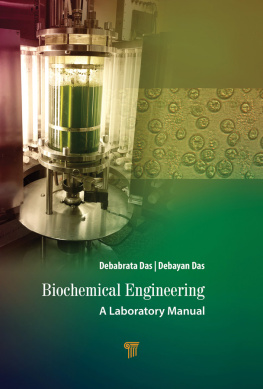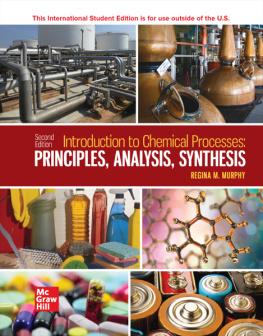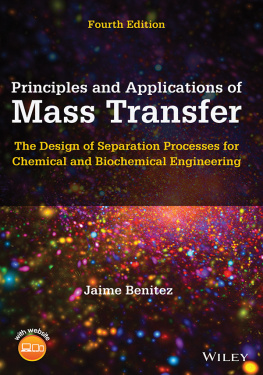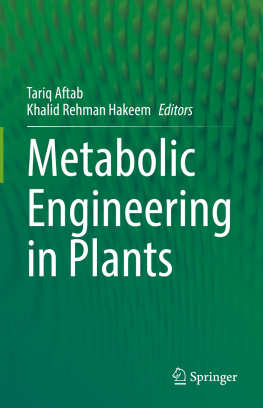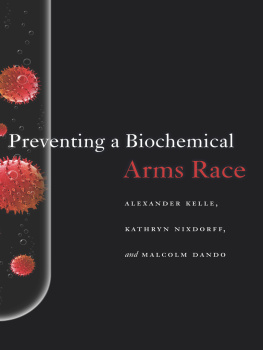Biochemical Engineering
A Laboratory Manual
Debabrata Das | Debayan Das

Published by
Jenny Stanford Publishing Pte. Ltd.
Level 34, Centennial Tower
3 Temasek Avenue
Singapore 039190
Email:
Web: www.jennystanford.com
British Library Cataloguing-in-Publication Data
A catalogue record for this book is available from the British Library.
Biochemical Engineering: A Laboratory Manual
Copyright 2021 Jenny Stanford Publishing Pte. Ltd.
All rights reserved. This book, or parts thereof, may not be reproduced in any form or by any means, electronic or mechanical, including photocopying, recording or any information storage and retrieval system now known or to be invented, without written permission from the publisher.
For photocopying of material in this volume, please pay a copying fee through the Copyright Clearance Center, Inc., 222 Rosewood Drive, Danvers, MA 01923, USA. In this case permission to photocopy is not required from the publisher.
ISBN 978-981-4877-36-7 (Hardcover)
ISBN 978-1-003-11105-4 (eBook)
Contents
Guide
Take risk in your life. If you win, you can lead.
If you lose, you can guide.
Swami Vivekananda
Biochemical Engineering mostly deals with complicated life systems in comparison to Chemical Engineering. Science gives us the reasoning behind the development of a new product, whereas engineering applies the science so that the product can be manufactured at the commercial scale. The authors have recently written a book titled Biochemical Engineering: An Introductory Textbook, published by M/s. Jenny Stanford Publishing. The present book is an attempt to describe experimental determination of several parameters involved in the operation of a bioreactor/fermenter.
Any report writing plays a crucial role in the proper communication of facts and figures. So the book initially includes a format of laboratory report writing for the betterment of students. A fermenter/bioreactor is the heart of biochemical processes. The specialty of a fermenter is essential to operate the system under aseptic condition to allow the growth of the desired microorganisms. The metabolic pathways of microorganisms are governed by different enzymes. So the book initially discusses determination of enzymatic reaction kinetics, followed by cell growth kinetics. The operation and analysis of different biochemical processes are required to find out the special features of the same. The book also discusses in detail determination of several parameters such as maximum velocity of reaction, the MichaelisMenten constant, maximum specific growth rate, saturation constant, true growth yield coefficient, maintenance coefficient, growth- and nongrowth-associated coefficients, air filtration efficiency, volumetric mass transfer coefficient, mixing time, determination of death rate constant, chemical oxygen demand, heat of combustion, etc.
The present book is a novel attempt to describe real experimental protocols to find out several kinetic parameters of biochemical processes as mentioned above. One of the authors has the experience of teaching Biochemical Engineering laboratory classes for more than three decades. This book is a comprehensive collection of different experiments based on the fundamentals of biochemical processes carried out by the undergraduate students of Biotechnology and Biochemical Engineering in the Indian Institute of Technology Kharagpur. It emphasizes on the determination of not only the characteristics of raw materials but also other essential parameters required for the operation of biochemical processes. It also focuses on the applicability of the analysis on different biochemical processes.
The readers will find this book a complete paraphernalia of knowledge about the experimental aspects of biochemical engineering process. Biohydrogen fermentation experimental protocol gives information on the methodology for finding out several parameters of cell growth kinetics. This information may be extended to other fermentation processes. Special experiments such as microbial fuel cells (MFCs) and biosorption kinetics are also included. The MFC is a unique devise to convert organic wastes to electricity. Contaminants (such as heavy metal ions) present in the industrial wastewater can be removed by the adsorption technique. The book consists of schematic diagrams of several experimental processes, photographs of the experimental setup, and comprehensive tables dealing with data and analysis of biochemical processes. Most of the sophisticated instruments are operated through computers. The standard operational protocols (SOPs) of a few instruments are also included at the end. Basic principles involved in the operation of different instruments have also been discussed. The proposed book is new in the market. It can be an ideal vade mecum for young researchers, teachers, and scientists endeavoring in the experimental aspects of biochemical engineering. The book is also appropriate for biochemical/chemical engineering, biotechnology, microbiology, and environmental biotechnology graduates, undergraduates, and industrial practitioners. Probable questions on experimental protocols have also been included at the end of the book as an exercise for self-evaluation.
The authors are thankful to Mr. Chandan Mahata and Dr. Jhansi L. Varanasi for their help in the various stages of manuscript preparation.
We hope this book will be useful to our readers!
Debabrata Das
Debayan Das
Summer 2020
| Specific growth rate of the cell, viscosity |
| m | Micron |
| max | Maximum specific growth rate |
| d | Specific death rate of the cell |
| Effectiveness factor, collection efficiency (experimental) |
| 0 | Overall collection efficiency |
| Single fiber efficiency |
| Growth-associated coefficient, volume fraction of the fiber |
| Nongrowth-associated coefficient |
| Absorption coefficient |
| Density of the fluid |
| y, c, m | Density of cell, density of suspension, density of media |
| Inertial parameter |
| Density of the fluid |
| p | Density of the particle |
| Hydraulic retention time |
| Specific product formation rate |
Spectrophotometer
Spectrophotometry is the quantitative measurement of the reflection or transmission properties of a material as a function of wavelength. It was first invented by Arnold O. Beckman in 1940. The most common spectrophotometric measurement is performed by a UV-VIS spectrophotometer, which uses light over the ultraviolet range (185400 nm) and visible range (400700 nm) of the electromagnetic radiation spectrum. Basic components of the instrument are light source, monochromator, sample holder, detector, and recorder. In a UV-VIS spectrophotometer, a light beam from a suitable source of ultraviolet and/or visible light passes through a monochromator prism. Light then passes the sample, and the transmitted light is measured at the detector. Light is absorbed by the liquid sample because it contains insoluble matter. Concentration of the sample is measured using the BeerLambert law, which states a linear relationship between absorbance and the sample concentration. The BeerLambert law can be expressed as

